
|
The Marketplace Tlatelolco (sorry--the right side is cropped here)Rivera's marketplace is "an encyclopedic presentation of the multiple products, services, activities, and personages to be seen at the great Aztec marketplace. Presided over by an enthroned official, all is calm and orderly in the market. . . . The painting gives no hint of Aztec imperialism, which the market symbolizes. Tribute and sacrifice victims were brought to Tenochtitlan from the subject peoples" (Goldman 104).
|
| |
|
Background with Aztec capital city Tenochtitlan and with volcanoes and snow-capped mountains of Popocatépetl and Iztaccihuatl in the distancePyramid, plazas, palaces, aquatic gardens, and canals indicate the wealth and prosperity of this meso-American city. The city was essentially an island built in Lake Texcoco. |
Blood on the stairs of the pyramidRivera idealized these native cultures but occasionally depicts a negative characteristic--here the bloodstains below the sacrificial stone on the stairs. |

|

|
| |
|
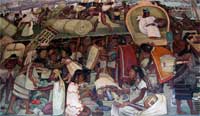
|
Judge and constable enthroned to insure orderConqueror Bernal Diaz del Castillo "said it would have been impossible to see it [the market] in one day due to its magnitude and variety. Here, flowers, fruits, vegetables, maize, cacao, fish, deer, minerals, gold, precious stones, ceramic objects, herbalist products, weavings, feathers, amate (bark) paper and other goods abound" ( Rodríguez 73). The market was also a medical clinic with healers practicing their cures. |
| |
|
Tattooed woman crowned with calla liliesProbably a courtesan, this beautiful woman raises her dress seductively while a warrior in a colorful headdress offers her a war trophy, the severed arm of a white enemy in exchange for her personal charms. However, the official guidebook identifies her as Xochiquetzal, the goddess of flowers and love, who is presented with gifts and trophies. The meat market is to the right with fish, ducks, iguana (?) and deer. |
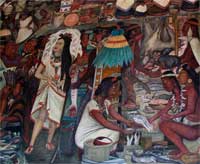
|
| |
|
Grisailles below the polychrome panel--from left to rightVarious agricultural and industrial activities are illustrated here: sowing, growing of maize, extracting maguey juice, paper manufacture, harvesting, cotton production, spinning and back-strap weaving. All of these activities in various towns made the great market possible. The middle panel (far right here) depicts the payment of tribute, "with which some towns contributed to the well-being of several small kingdoms. Apart from this reference to the exploitation of non-local labor in the form of tribute, there is nothing in the entire mural series of the Palace corridor that darkens Rivera's idealized image of the pre-Hispanic world" ( Rodríguez 76). |
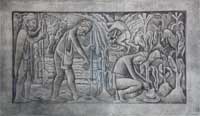
|
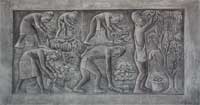
|

|
| |
|
|
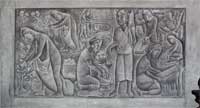
|
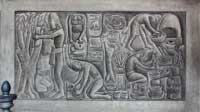
|


 Go to Rivera Murals Index.
Go to Rivera Murals Index. Go to the Mexico Index.
Go to the Mexico Index. Click here to return to index of art historical sites.
Click here to return to index of art historical sites.
 Click here to return to index of artists and architects.
Click here to return to index of artists and architects.
 Click here to return to chronological index.
Click here to return to chronological index.
 Click here to see the home page of Bluffton University.
Click here to see the home page of Bluffton University.

